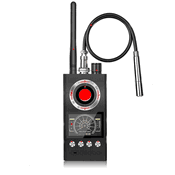Shop All Items
Bug Detector / RF Signal Detector
Bug detectors pick up radio frequencies from all around your home or office. Since they respond to any wireless device, sweeping for bugs can be somewhat time consuming and difficult, but it’s well worth the time to know if someone is spying on you. Being able to sweep your office or house for bugs can be very helpful if you have a high-risk job (like working with a government agency) or are in the middle of a lawsuit. What you say over the phone or in the presumed privacy of your home could be evidence against you if it fell into the wrong hands.With RF signal detectors, you can protect private conversations by making sure there are no bugs in your walls or taps on your phones. Use bug detectors to see if your phone, computer or home is bugged with hidden cameras, wireless transmitters, or GPS trackers. Bug detectors can provide light, audible or vibration responses to radio frequencies to let you know you might be onto something. Because bug detectors pick up any radio frequency, you’ll have to rule out anything within its range, including cell phones, laptops and any other device that gives off between 50 megahertz (MHz) to 6 gigahertz (GHz). On the low end of the spectrum, a good bug detector will be able to pick up voice transmitters around 50 MHz and continue up the scale to wireless cameras, but this wide range of frequency is common among a lot of everyday items. You’ll also have to think about your neighbors and the modems and receivers they’re using while you’re sweeping your home or office with a bug detector.
To begin the process, turn off all of your wireless devices. With your modem, your cell phone, and other devices off, you’d think that whatever else you find would be cause for concern but not so fast. Interference of other radio frequencies around you can be picked up by the bug detector, too, including frequencies from microwaves, televisions and even power lines.
If you’re doing this yourself, it may be difficult to know if you’ve found a bug or not. Bug detectors don’t just hone in on bugs, they hone in on radio frequencies. This is why bug detection should be left up to the professionals. Rather than opening holes in the wall all over your house, professionals know some common areas where hidden devices are usually placed and where you’re least likely to look.
A qualified technical security expert will be better able to discern a true bug’s frequency from normal interference and identify any and all weaknesses in your home security or that of your office or business. The sweeps that the professionals do is much more in depth than anything you could do on your own without proper training and certification. These sweeps include a full electronic search of the spectrum of radio frequency, and a search in walls, ceilings, furnishings and elsewhere for active and dormant recorders, transmitters or microphones.
If you’re going to do this bug detection yourself, you might want to check the exterior as well as interior features of your home, such as crawl spaces and ventilation and plumbing systems for evidence of eavesdropping, like smears or footprints in dust. Of course, as this assessment is being done (by you or a professional team), you should have important conversations face to face or in writing and in a surely secure location.
Shop By Category
















